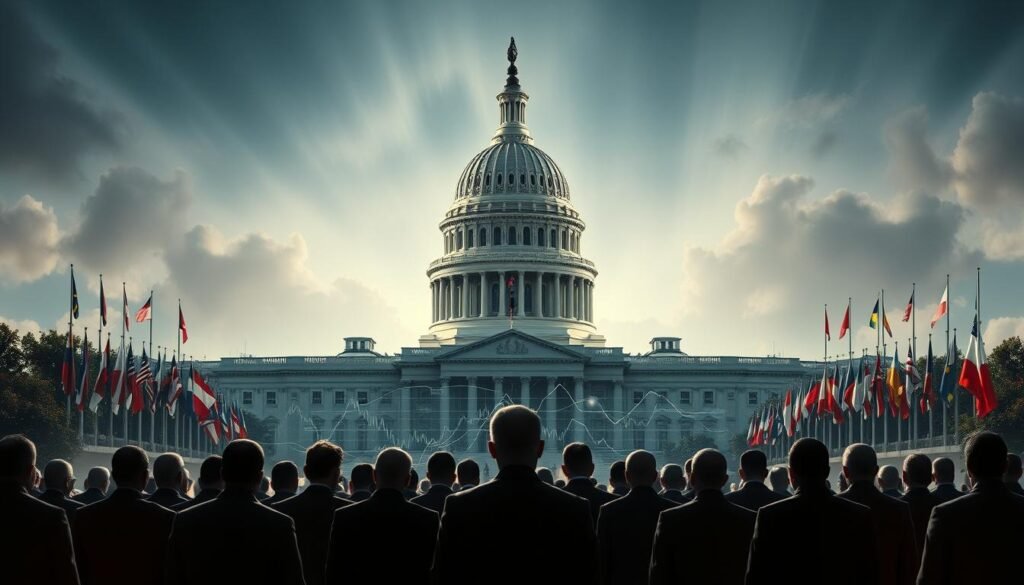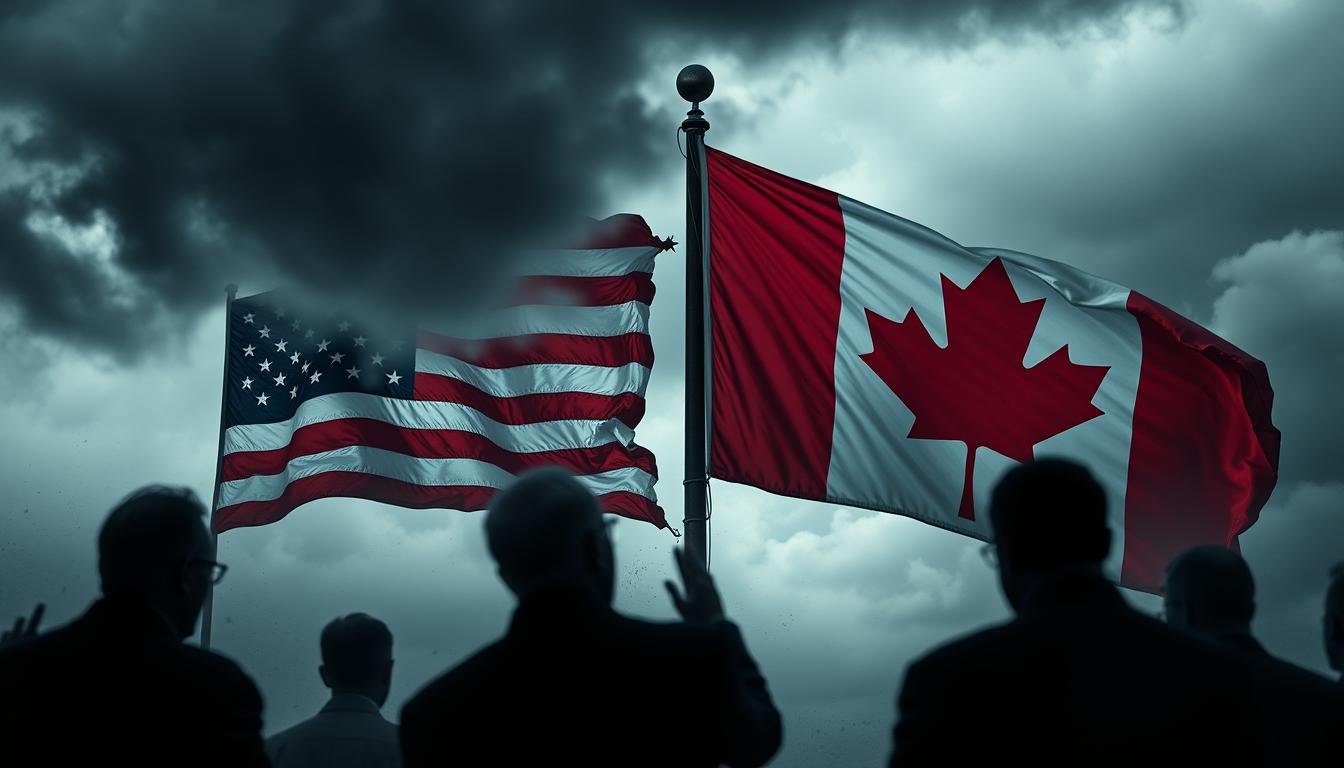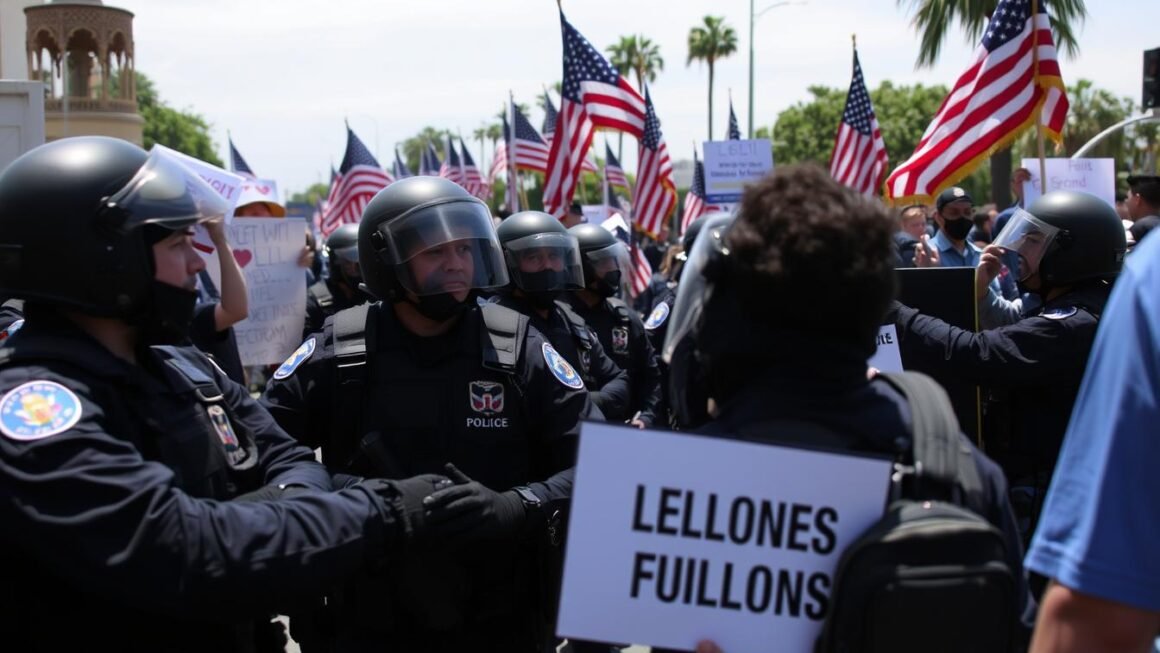“A house divided against itself cannot stand,” said Abraham Lincoln. This insight is more relevant than ever in the U.S.-Canada tariff fight. You might wonder, “What’s the big deal?” It’s more than a tariff issue; it’s about unity versus division.
This battle is a clear example of our struggle with trust and working together. Should we act united or argue over small things? Let’s explore what this economic dispute teaches us about unity and community.
Key Takeaways
- The U.S.-Canada tariff trade battle symbolizes deeper issues of trust and collaboration.
- Unity is essential to overcoming divisions in trade relationships.
- Lessons from this conflict reflect on community and interconnectedness.
- Economic disputes can reveal the need for stronger relationships.
- The quote from Lincoln serves as a poignant reminder of the importance of unity.
- This tariff debate highlights the spiritual essence behind trade conflicts.
Understanding the U.S.-Canada Trade Relationship
Imagine the U.S.-Canada trade relationship as a 90s sitcom, full of twists and laughs. Over years, they’ve grown to rely on each other, thanks to trade. Deals like NAFTA, now known as USMCA, have brought our economies close like a warm hug.
The latest USMCA version strengthens this bond. It tackles new trade challenges, showing our dedication to help each other.
In this commerce dance-off, the U.S. and Canada are top partners. Wonder who dances better with goods like lumber and cars? It’s a tough call, but their teamwork is unmatched. Let’s now dive into the key trade figures between these countries.
| Aspect | U.S. Exports to Canada | Canadian Exports to the U.S. |
|---|---|---|
| Lumber | $4 billion | $6 billion |
| Automobiles | $23 billion | $19 billion |
| Agricultural Products | $20 billion | $1.5 billion |
| Machinery | $18 billion | $15 billion |
This partnership is more than just numbers. Trade deals boost innovation and create jobs, showing teamwork beats going solo. You’ll find friends in maple leaf tees and American flags, together. Whether joking about weather or hockey, we’re all part of one big team.
The Origins of the Tariff Trade Battle
Imagine a family feud that starts over a forgotten video game. Sounds silly, right? The U.S. and Canada’s tariff battle also started from old disagreements and trade policies. It affects both countries a lot. Think of it like the stories that one uncle always shares at family get-togethers.
The story starts way before we had cool electronics or video games. As the U.S. and Canada built their economies, they made choices leading to today’s trade issues. For example, many policies were shaped by lobbyists and businesses that liked higher tariffs. It’s a repeating cycle that can make anyone sigh.
Whenever one country sets a new tariff, the other country responds. This back-and-forth makes things more complicated. It leaves people wondering if all this trouble is worth it. Maybe replacing trade problems with a simple board game would be better.
| Event | Impact |
|---|---|
| 1866 – British North America Act | Established Canada’s trade policies independently, leading to tensions. |
| 1930 – Smoot-Hawley Tariff | Increased tariffs and retaliatory measures fueled the trade war. |
| NAFTA (1994) | Created a framework for trade, but conflicts keep surfacing. |
| 2018 – U.S.-Canada Trade Dispute | Tariffs on aluminum and steel reignited trade policy debates. |
Learning about these historical events helps us understand the ongoing tariff battle. It began with simple misunderstandings and politics. Now, it’s a topic that can make dinner parties awkward. Are we doomed to always argue, or can we find peace? Only time will tell.
Economic Impacts of Tariff Policies
Let’s dive into how tariff policies shake things up. They flip the business world on its head and give shoppers a wake-up call. This change affects everyone involved.
Effects on Businesses
Companies find themselves in a storm due to tariffs. It’s like playing Jenga—make one wrong move, and everything could fall. So, businesses think twice about how they make stuff.
Here’s what that means:
- Operating costs go up, making profits narrower.
- Big players in industries like cars and tech may put growth plans on hold.
- Some cut jobs to deal with rising costs, showing the wide effects.
Seeing how tariffs impact businesses highlights the need for agility. Quick-to-adapt companies might get ahead, while others struggle. It’s a tough spot, making stress balls a must-have!
Impact on Consumers
Now, look at how this affects you, the buyer. Noticed how that good bottle of Canadian maple syrup got more expensive? Tariffs make some regular items feel overpriced. Keep this in mind:
- Price increases are not just on maple syrup but on lots of imports.
- As companies face higher costs, they make you pay more.
- Some goods become hard to find, leading to a rush to buy them.
Shopping trips might make your wallet thinner. These policies change how we buy, showing our connection in the trade web.
Historical Context: Lessons from the Past
History teaches us quirky lessons, often through big mistakes. Looking back at trade conflicts shows how past events shape today’s economic choices. It’s like being a time traveler in trade, peeking into the past to see why certain decisions were made. One example is the Smoot-Hawley Tariff of the 1930s. This event is a classic example of how economic mistakes can make situations worse.
Previous Trade Conflicts
Diving into the history of trade conflicts is like exploring turbulent waters. When countries start trade wars, the effects can be huge, like tidal waves. From the Great Depression’s Smoot-Hawley Tariff to today’s tensions, there’s much to learn. These insights can help us avoid making the same mistakes again.
| Trade Conflict | Year | Key Outcomes |
|---|---|---|
| Smoot-Hawley Tariff | 1930 | Led to a massive decline in trade; worsened the Great Depression. |
| U.S.-Japan Trade War | 1980s | Increased tensions; Japan’s economy shifted significantly. |
| China-U.S. Trade Conflict | 2018-Present | Escalating tariffs impacting global supply chains and consumer prices. |
These trade conflicts teach us about the consequences of economic actions. By studying the past, we can avoid future mistakes. It’s interesting how we often end up in similar scenarios, feeling confused. We should aim to avoid repeating these historical economic mistakes.
The Political Landscape Surrounding Tariffs
Ah, the political scene is like a drama when it comes to tariffs. It might seem focused on trade and money. But, it’s more about showing off and political games. Politicians act as if it’s their job to sprinkle tariffs everywhere, trying to sell us the idea of economic safety. But the truth? It’s not so simple.
Lobbyists hustle, whispering to politicians, urging for tariffs that cause arguments. These actions are often shown as ways to protect American jobs. Everyone likes the idea of being a hero, right? But look closer, and it’s like uncovering layers—sometimes, it ends in tears.
These tariff policies can have hidden motives, leading to outcomes we didn’t expect. We might notice some benefits early on, but the long-term effects can be puzzling. These political moves make us wonder if they truly bring us together or just divide us more.

The Spiritual Implications of Division
Now, let’s look beyond tariffs and touch on something deeper: our collective spirit. This trade fight isn’t just about numbers. It shows how split we’ve become and the spiritual fallout of that. We argue about trade, missing out on a key fact: real growth comes from being united, not divided. A divided society? It’s not going to be pleasant, trust me.
Unity vs. Division in Society
Imagine a world where we work together instead of just talking behind each other’s backs. It sounds nice, doesn’t it? Being united makes us feel part of something bigger. It’s vital for us to flourish as individuals and as a group. On the flip side, being split up makes us feel alone, like a lost sock in the wash.
In simple terms, focusing on what divides us—like trade disagreements or cultural clashes—means we miss the real deal. Look around; we’re stronger together, focusing on common ground, not differences. Accepting this can be hard, especially when tempers flare, like at family events where discussions turn political.
Exploring the Concept of a “Divided House”
Let’s explore the idea of a divided house. This concept is about more than buildings. It reflects challenges in relationships among people and communities. A divided house suggests conflict and struggle, affecting togetherness.
Think of times when friends or family fought over a disagreement. Just one misunderstanding can cause hard feelings and separation. These conflicts can end up hurting what was once strong and united.
In society, unity is valued, but conflict is common. It runs through social media and daily conversations. Discussions on things like tariffs divide people, showing a clear split in opinions.
So, what can we do to fix a divided house? It starts with seeing conflict as a sign of deeper issues. Understanding these problems can help bring people back together. After all, a divided house is not a happy place for anyone.
Cross-Border Relations in a Tariff Trade Battle
When you think of the U.S.-Canada dynamic, you might picture friendly neighbors. They trade poutine for burgers. But, throw tariffs into the mix, and it’s like a sitcom with misadventures. The border lands are more than lines on a map. They hold deep cross-border relations that impact all sorts of goods.
Adding tariffs to this mix complicates things further. It’s not just a small obstacle. It’s like a plot twist in a reality show. Suddenly, trade between the two countries becomes tense. Each tariff is like a message left unanswered, leading to frustration and uncertainty about what’s next.
Finding a balance in the U.S.-Canada dynamic is crucial. It allows goods and culture to flow freely. Working together on issues like environmental policies or tech shows how beneficial this can be. But, tariffs can make those moments of camaraderie hard to come by.
Navigating trade intricacies needs diplomacy and understanding. It’s like solving a puzzle in a buddy-cop film. Dealing with tariffs or celebrating wins, strong cross-border relations are key. They help both countries thrive together.
Public Reaction: Voices from Both Sides
What’s everyone talking about across the border? The new tariff dispute has sparked lots of talks. People share their thoughts, mixing Canadian kindness with American energy. It’s like arguing over who has the best maple syrup—everyone’s got an opinion!
U.S. Perspectives on Tariffs
Many in the U.S. think tariffs are needed to save jobs. Small business owners worry about climbing costs. They’re trying to budget and keep their business running. A Seattle grocery clerk might say, “I’m just trying to get by as prices soar!” This feeling is common, as real-life troubles meet policy decisions. Folks are looking for solutions that help them locally.
Canadian Responses to Trade Policies
Canadians are actively responding. Their reactions mix annoyance with a determination to overcome. Toronto businesspeople talk about adapting and finding new strategies. They often say, “We’ll adapt somehow,” showing typical Canadian hope. This creates a community feeling. From pastry chefs to hockey players, Canadians unite to discuss how tariffs affect their lives and favorite blueberry pies.
The debate between the countries shows how trade can stir strong feelings. Each side has its viewpoint, leading to lively talks. Who would have thought trade issues could bring out so much passion?
Media Coverage and Its Role in Perception
Let’s talk about the media and its big role in shaping what people think. When media covers the tariff trade issue, it’s like a rollercoaster. It’s full of drama. The saying “If it bleeds, it leads” fits well here. How news is presented can either bring people together or push them further apart.
Have you noticed how different channels tell the same news in different ways? One might say tariffs are good for American jobs. Another might say they just cause problems for shoppers. These differences affect how we view the US and Canada’s relationship. It makes us wonder, are we close friends or just neighbors with boundaries?
To show what I mean, see how different outlets reported the same news:
| Media Outlet | Headline Example | Framing Technique | Public Sentiment |
|---|---|---|---|
| Outlet A | “Tariffs Save American Jobs!” | Patriotic Appeal | Supportive |
| Outlet B | “Consumers Pay the Price for Unnecessary Tariffs” | Fear Induction | Critical |
| Outlet C | “A Straightforward Trade War: Who’s Winning?” | Analytical | Mixed |
Media stories can either help us understand or get us confused about big issues like tariffs. The key point? Notice how media changes your view. Question yourself: Are you getting facts or just a viewpoint? Be careful with dramatic headlines. They might mess with your understanding of what’s happening.
Lessons on Cooperation and Conflict Resolution
Imagine being as wise as an owl on cooperation and conflict resolution. Remember when someone took your lunch at school? You traded an apple for a chocolate bar, and that was that. This simple act shows the power of making deals.
In the world of international relations, things are more complex, but the basic idea is the same. Countries can really benefit from learning how to negotiate and solve problems together.
Good cooperation is built on some important tactics. It’s key to talk openly, listen to others, and aim for solutions that everyone is happy with. When countries do this, they get along much better. Stories from the workplace show us that talking clearly and solving problems together can prevent a lot of conflicts.
It seems silly to keep fighting when talking can solve our problems, right? Bringing humor and a little humility into the conversation can help smooth things over. Everyone likes to laugh, even when working out the details of important deals. Remember, even in serious talks, a bit of fun can make resolving conflicts easier.
Finding Common Ground in the Midst of Division
Imagine a group of people coming together, wanting to find common ground despite their differences. This feels rare, right? When talking about U.S. and Canada trade, unity is vital, not just a nice thought. Even when opinions clash, especially on tariffs, there’s still a chance for working together beautifully.
Think about solving these issues with cooperation. Countries can avoid conflicts and work on solutions together. When countries collaborate, they find ways to understand each other better. They also boost prosperity for everyone. And really, who wants to argue over tariffs with so much delicious maple syrup around?
Building relationships on dialogue and respect helps U.S. and Canada trade leaders. They show that being divided isn’t the only option. And a little humor can make things smoother. Instead of arguing about tariffs, working on enjoying snacks together seems much better. Now, that’s a productive idea!
Reaching that *sweet spot* of agreement needs dedication and creative thinking. It pushes everyone to prefer cooperation over conflict. Every talk is a chance to celebrate shared values, like respect and kindness. And maybe, a shared love for great music (say hi to Justin Bieber and Drake!). The main aim? It’s about uniting for a common future, not just avoiding fights.
The Role of National Identity in Trade Battles
Trade battles can remind us of high school rivalries. Imagine the U.S. and Canada as buddies poking fun at their national pride. We often find tariffs stirring up feelings of patriotism, making us cheer for our country.
You might shout “USA!” while your friend beams with Canadian pride. It becomes less about shopping and more about which flag we’re holding.
National pride is hugely important in this debate. Discussions quickly turn from economic impacts to a competition of patriotism. This rivalry turns our self-identity into a joke, linked to policies that might not greatly impact us financially.
Trade disputes bring up conversations about our global role. It’s like a neighborhood cook-off, where everyone boasts about their dish. At heart, we believe trade should focus on benefits for all, much like sharing recipes over arguing about tariffs.
In the end, while our national identity unites us, cooperation usually offers better outcomes for all. Next time there’s talk of a tariff, remember it’s fine to be patriotic while also welcoming others for a friendly barbecue.
Future Implications for U.S.-Canada Relations
Let’s peek into the future of U.S.-Canada relations. Imagine the scene: trade talks are heating up against the backdrop of upcoming elections and a changing economy. It feels like the climax of a thrilling reality show. What comes next? Will partnerships get stronger or will trade issues grow? It’s anyone’s guess.
While predicting the economy isn’t easy, we must watch certain trends. These could change U.S.-Canada ties. Leadership changes, market shifts, and global economic trends will play key roles. It’s like chess, each move matters.
Experts are watching how new trade rules will impact both countries. We can’t ignore the environment or cultural ties. With trade negotiations ahead, how we talk and agree on things will change. This could affect tariffs and finding common ground.
| Potential Changes | Possible Impacts | Long-Term Effects |
|---|---|---|
| New Trade Agreements | Increased economic collaboration | Stronger bilateral ties |
| Escalated Tariffs | Higher prices for consumers | Demand for local goods may rise |
| Shift in Leadership | New policies and priorities | Potential for conflict or resolution |
| Global Economic Changes | Pressure on trade dynamics | Lengthened negotiations |
The future of U.S.-Canada relations is full of unknowns. Though cliffhangers can be thrilling, one thing is sure: these nations will keep evolving. So, get ready for an adventure!
Conclusion
As we finish our journey through the U.S.-Canada trade disputes, it’s a good time to reflect. This story showed us how important it is to stick together in our connected world. After all, nobody likes a divided group.
Sometimes, we need to stop arguing—like when fighting over pizza. We must look at the big picture. It’s more valuable than any pizza topping.
This situation taught us more than just politics. It showed how working together is better than fighting. Looking ahead, we should aim for a world where both countries prosper together. Isn’t that much better and more fun?
Imagine happy get-togethers, laughter, and maybe some maple syrup. Picture sharing these good times and sweetening the relationship.
In the end, as we deal with trade complexities, we should cherish teamwork and collective victories. It’s like a beloved TV show where everyone ends up getting along. By valuing unity in trade, we’ll see a brighter future. Let’s hold onto the thought that together, we’re stronger. This belief is key, especially as we navigate global trade’s challenging roads.



